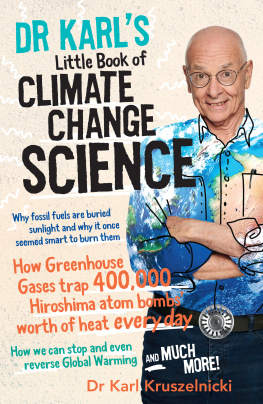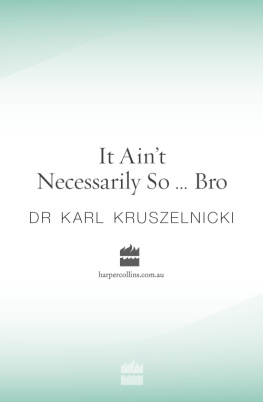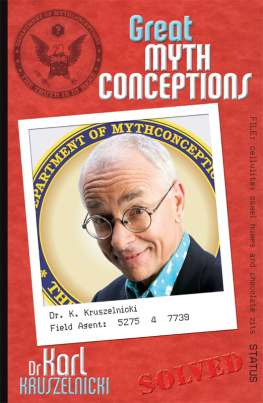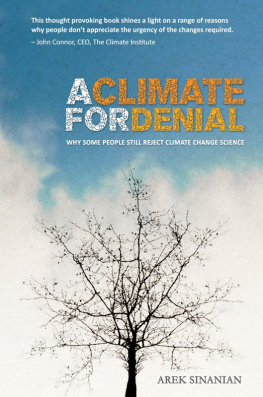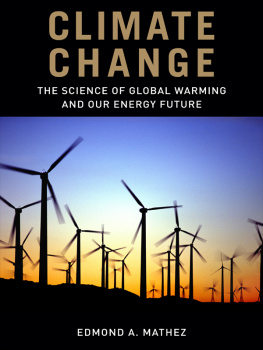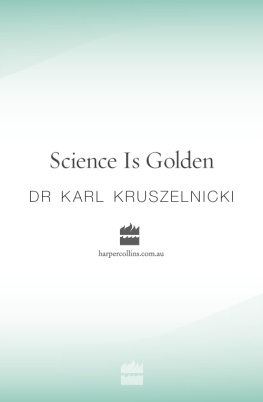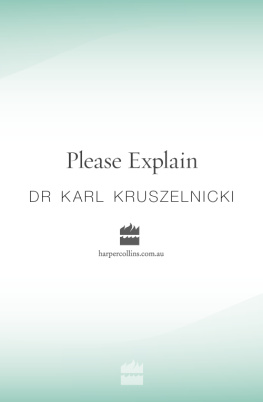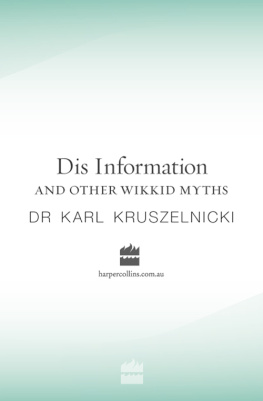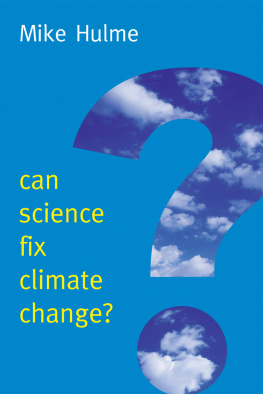Karl Kruszelnicki - Dr Karls Little Book of Climate Change Science
Here you can read online Karl Kruszelnicki - Dr Karls Little Book of Climate Change Science full text of the book (entire story) in english for free. Download pdf and epub, get meaning, cover and reviews about this ebook. year: 2021, publisher: HarperCollins Publishers, genre: Children. Description of the work, (preface) as well as reviews are available. Best literature library LitArk.com created for fans of good reading and offers a wide selection of genres:
Romance novel
Science fiction
Adventure
Detective
Science
History
Home and family
Prose
Art
Politics
Computer
Non-fiction
Religion
Business
Children
Humor
Choose a favorite category and find really read worthwhile books. Enjoy immersion in the world of imagination, feel the emotions of the characters or learn something new for yourself, make an fascinating discovery.
- Book:Dr Karls Little Book of Climate Change Science
- Author:
- Publisher:HarperCollins Publishers
- Genre:
- Year:2021
- Rating:3 / 5
- Favourites:Add to favourites
- Your mark:
- 60
- 1
- 2
- 3
- 4
- 5
Dr Karls Little Book of Climate Change Science: summary, description and annotation
We offer to read an annotation, description, summary or preface (depends on what the author of the book "Dr Karls Little Book of Climate Change Science" wrote himself). If you haven't found the necessary information about the book — write in the comments, we will try to find it.
Dr Karls Little Book of Climate Change Science — read online for free the complete book (whole text) full work
Below is the text of the book, divided by pages. System saving the place of the last page read, allows you to conveniently read the book "Dr Karls Little Book of Climate Change Science" online for free, without having to search again every time where you left off. Put a bookmark, and you can go to the page where you finished reading at any time.
Font size:
Interval:
Bookmark:

DR KARL KRUSZELNICKI has put his 28 years of education to good use, finding weird but true stuff about the Universe and sharing it with fellow curious minds.
He does this via radio, TV, magazines, books, personal appearances, interpretative dance, and social media (including Twitter and TikTok).
He won the 2019 UNESCO Kalinga Prize for the Popularisation of Science, as well as an Ignobel Prize for his ground-breaking research into belly button fluff and why it is almost always blue.
This book is important because its about our future, and how we can make it better.
Scientists have been investigating the temperature of the Earths atmosphere for centuries. But for a few decades in the second half of the 20th century, fossil fuel companies got in on the action. At first, they did real science but then they shifted to chicanery.
As far back as the mid-1600s, the Medici Network (which sounds a bit like an organised crime syndicate but was actually the worlds first weather service) was already taking continuous measurements of air temperature across Europe.
The experimental basis of Global Warming was established in 1856, when the American scientist Eunice Newton Foote measured how different gases absorbed the heat of the Sun. As a result, she correctly predicted that extra carbon dioxide in the atmosphere would increase air temperature.
In the 20th century, surprisingly, fossil fuel companies carried out much of the research into Climate Change, beginning in the mid-1970s. In 1982, they predicted, with remarkable accuracy, what the carbon dioxide levels and air temperatures would be in 2020 if the current trend in burning fossil fuels continued. Back then, they accepted the science of Climate Change and, as good corporate citizens, they rejected projects that would release too much carbon dioxide into the atmosphere.
Around 1990, however, Big Fossil Fuel did a U-turn and began a very active and massively well-funded cover-up of the real science.
And here we are at the start of the third decade of the 21st century. Lets dive into the details of how we got to our current state of Global Warming by looking at how the science was done and how it was covered up.
Probably the earliest known temperature measurements ran from 1654 to 1670. The so-called Medici Network took temperature measurements every 3 to 4 hours at 11 locations. The two main stations were in Florence (at sea level) and Vallombrosa (1 km altitude) in Italy, with other stations scattered across Europe (including Paris, Warsaw and Innsbruck). The enterprise was funded and supported by the Medici family, which supported science in the same way it supported the arts. After all, at that time, it was not known if ice always melted at the same temperature, or what the range of air temperatures was in different countries, for example.
The stations all used identical thermometers (the newly invented Little Florentine Thermometer) mounted in a similar manner pretty smart.
In 1824, Joseph Fourier, a French physicist and mathematician, published his deep thoughts about Earths atmosphere. Why was Earths temperature what it was, and not hotter or colder?
There were, Fourier realised, three potential sources of heat for the Earth: the Sun, Earths core and space (the rest of the Universe).
He also realised there was a fourth factor: Earths atmosphere. Somehow, this trapped some of the Suns heat, preventing it from leaving, and so warming the Earths surface. Without an atmosphere, he observed, the Earth would be much colder. Fourier was one of the first to recognise what would be later called the Greenhouse Effect.
Fouriers work was purely theoretical, however he didnt carry out any experiments.
In 1838, the French physicist Professor Claude Pouillet measured the solar constant (the average amount of power per square metre the Sun delivers to the Earth, at the upper edge of the atmosphere). Using equipment (called a pyrheliometer) he built himself, he estimated that the Sun delivers 1,228 Watts per square metre, or Watts/m2 (remarkably close to todays more accurate estimate of 1,361 Watts/m2).
Pouillet was a gifted experimenter, but he didnt identify any atmospheric gases that could trap the suns heat.
In 1856, Eunice Newton Foote, an American scientist, inventor and womens rights campaigner, did the first experiment to identify which gases could force the atmosphere to heat up. Foote filled glass cylinders about 75 cm long and 10 cm in diameter with different gases, such as hydrogen, oxygen, carbon dioxide and so on. She left them in direct sunlight to find out how much each gas heated up.
She discovered that hydrogen heated up the least, while carbon dioxide became the hottest. Then Foote made the chilling prediction that an atmosphere of that gas [carbon dioxide] would give to our Earth a high temperature.
Irish physicist John Tyndall took the next step with a series of experiments around 1860.
Tyndall had the dual advantages of being a man, and of having easy access to the considerable resources of Englands Royal Institution (an organisation dedicated to scientific research and education). His experiments measured that carbon dioxide could trap nearly 1,000 times as much heat as dry air.
Tyndall summarised the physics behind Global Warming accurately: Thus the atmosphere admits of the entrance of the solar heat; but checks its exit, and the result is a tendency to accumulate heat at the surface of the planet.
So, all the way back in 1860, we discovered that the atmosphere will easily let in the Suns heat but will stop most of it from leaving.
By 1894, scientists were very confident that carbon dioxide was deeply implicated in helping to set our atmospheres temperature. But back then, they had only a very poor understanding of how carbon atoms moved around in the biosphere (for example, how they move from the atmosphere into a tomato, into you, then out of your mouth and into the ocean, where they dissolve and then become part of a coral, then into a fish, etc.). This movement of carbon atoms into (and out of) natural and human sources (and sinks) is called the Carbon Cycle.
The Swedish geologist Arvid Hgbom did much of the early work on the Carbon Cycle in the late 1800s.

(Based on illustration at onlinesciencenotes.com/the-carbon-cycle/)
Arvid Hgbom and Svante Arrhenius were colleagues. Hgboms ground-breaking work on the Carbon Cycle was essential for Arrhenius, who tried to predict how changing carbon dioxide levels in the atmosphere would affect the Earths temperature.
In 1896, after doing tens of thousands of calculations all by hand, without a calculator Arrhenius concluded that human activity was making the Earths atmosphere warmer.
In 1906, he fine-tuned his work, predicting: Any doubling of the percentage of carbon dioxide in the air would raise the temperature of the Earths surface by 4C. This was impressively close to current predictions.
Font size:
Interval:
Bookmark:
Similar books «Dr Karls Little Book of Climate Change Science»
Look at similar books to Dr Karls Little Book of Climate Change Science. We have selected literature similar in name and meaning in the hope of providing readers with more options to find new, interesting, not yet read works.
Discussion, reviews of the book Dr Karls Little Book of Climate Change Science and just readers' own opinions. Leave your comments, write what you think about the work, its meaning or the main characters. Specify what exactly you liked and what you didn't like, and why you think so.

